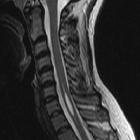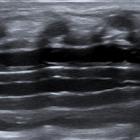syringomyelia







Syringomyelia refers to a cystic collection, or syrinx, that occurs within the spinal cord around the central canal.
Terminology
Although syringomyelia is distinct from hydromyelia, in which there is simply dilatation of the central canal, it is very difficult to distinguish the two on imaging. Hence, the collective terms hydrosyringomyelia or syringohydromyelia can also be used to describe this fluid collection within the cord.
Clinical presentation
Patients with this condition demonstrate a wide variety of neurological symptoms depending on where exactly the syrinx is located, but classically patients present with:
- a cape-like loss of pain and temperature sensation along the back and arms, known as a ‘suspended sensory level’
- disproportionately greater bilateral motor impairment in upper compared to lower extremities
This motor and sensory impairment can eventually cause atrophy, which begins in the hands and progresses proximally, resulting in deformities such as 'claw hands' and Charcot’s arthropathy .
Pathology
Syringomyelia applies to any cavity within the substance of the spinal cord that may or may not communicate with the central canal (ependyma does not line the cavity wall). In syringomyelia, there is a dissection of the ependymal lining of the central canal and CSF collection within the cord itself. Therefore, the collection does not have an ependymal lining.
Characteristically, the syrinx is in the cervicothoracic cord, with C2 to T9 being the most common location, however, the lesion may descend all the way down to the conus medullaris. There are numerous causes and associations, and these are discussed in more depth in the general article on syrinx.
Radiographic features
Syringomyelia has the same radiographic characteristics on all imaging modalities as any other syrinx. See syrinx for an in-depth discussion of these characteristics.
Treatment and prognosis
When symptomatic, neurosurgical intervention may be required .
Siehe auch:
- Chiari-Malformation Typ 1
- Klippel-Feil-Syndrom
- Arnold-Chiari-Malformation Typ 2
- Syrinx
- Ventriculus terminalis
- Myelomeningozele
- Dandy-Walker-Syndrom
- Hydromyelie
- Syringobulbie
und weiter:
- Basiläre Impression
- vertebrale Metastasen
- Skoliose
- Tethered cord
- chronisch adhäsive Arachnopathie
- spinale Epidermoidzyste
- spinale Metastasen
- holocord presentation
- erweiterter Spinalkanal
- Lepra
- hematomyelia
- Erweiterung des interpedunculären Abstands
- Chiari-Malformation Typ 3
- terminology of spinal cord cavities
- posttraumatic syringomyelia

 Assoziationen und Differentialdiagnosen zu Syringohydromyelie:
Assoziationen und Differentialdiagnosen zu Syringohydromyelie:






